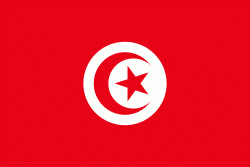Hammam-Lif (Hammam Lif)
Hammam-Lif (حمام الأنف, pronounced hammam linf) is a coastal town about 20 km south-east of Tunis, the capital of Tunisia. It has been known since antiquity for its thermal springs originating in Mount Bou Kornine.
Naro, which means fire, was Hammam-Lif's Punic name. In 1883, the French captain Ernest De Prudhomme discovered in his Hammam-lif residence the first archeological ruins of an ancient synagogue that once stood in Hammam-Lif in 3rd-5th century AD.
Hammam-Lif was once the home of Italian, Greek and Jewish communities, especially before the end of the French colonial period.
Hammam-Lif's most interesting site is probably Dar El Bey, which was the residence of Ali II Bey, the 4th bey of Tunis.
Naro, which means fire, was Hammam-Lif's Punic name. In 1883, the French captain Ernest De Prudhomme discovered in his Hammam-lif residence the first archeological ruins of an ancient synagogue that once stood in Hammam-Lif in 3rd-5th century AD.
Hammam-Lif was once the home of Italian, Greek and Jewish communities, especially before the end of the French colonial period.
Hammam-Lif's most interesting site is probably Dar El Bey, which was the residence of Ali II Bey, the 4th bey of Tunis.
Map - Hammam-Lif (Hammam Lif)
Map
Country - Tunisia
 |
 |
| Flag of Tunisia | |
Beginning in early antiquity, Tunisia was inhabited by the indigenous Berbers. Phoenicians began to arrive in the 12th century BC, establishing several settlements, of which Carthage emerged as the most powerful by the 7th century BC. Carthage was a major mercantile empire and a military rival to the Roman Republic until 146 BC, when it was defeated by the Romans who occupied Tunisia for most of the next 800 years. The Romans introduced Christianity and left architectural legacies like the Amphitheatre of El Jem. In the 7th century AD, Arab Muslims conquered all of Tunisia (finally succeeding in 697 after several attempts starting in 647) and settled with their tribes and families, brought Islam and Arab culture to the local inhabitants, and since then Arabs became the majority of the population. Then, in 1546, the Ottoman Empire established control there, holding sway for over 300 years, until 1881, when the French conquered Tunisia. In 1956, Tunisia gained independence as the Tunisian Republic under the leadership of Habib Bourguiba with the help of activists such as Chedly Kallala, Farhat Hached and Salah Ben Youssef. Today, Tunisia's culture and identity are rooted in this centuries-long intersection of different cultures and ethnicities.
Currency / Language
| ISO | Currency | Symbol | Significant figures |
|---|---|---|---|
| TND | Tunisian dinar | دت | 3 |
| ISO | Language |
|---|---|
| AR | Arabic language |
| FR | French language |















